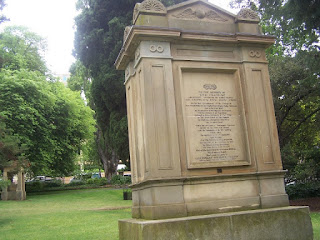The National Championships were held in Hobart in the middle of November when the city was preparing for Christmas. Elizabeth Street Mall was around the corner from the hotel so we walked through it regularly. As you can see the Mall was brightly decorated for the festive season.
There were also Christmas decorations throughout other areas of the central city area. On the morning we left Hobart crowds were assembling for the Santa Parade through some of the city streets.
Further along Elizabeth Street a board outside a cafe welcomed the cricketers to Hobart.
Hobart has many buildings of historical interest.
The
Hope and Anchor Tavern at 65 Maquarie Street is advertised as being the oldest hotel in Australia or at least the oldest hotel continuously operating on one site. Obviously there have been alterations to the original building over the years and also a number of name changes - the
Whale Fishery, the
Hope, the
Anchor and Hope and the
Alexandra since its establishment in 1807.
City Hall is located on the block between Collins Street, Campbell Street, Macquarie Street and Market Place. The actual address is 57-63 Macquarie Street. Before being destroyed by fire in 1909 the New Market building occupied this site. The enclosed market building was
opened in 1854.
Another interesting building in this area is the
Theatre Royal at 29 Campbell Street which was
opened in 1837 and is still operating. The above
image is from Think Tasmania blog.
The area from around the Theatre Royal down to the docks was known as Wapping and until recently part of the area was classed as a slum area.
St David's Cathedral is located at 125 Macquarie Street on the corner of Murray Street. In 1817 the foundation stone was laid and the church was opened in 1823. There have been many
alterations to the building including the rebuilding of the cathedral in 1868.
The first St David's Church was built in 1811 and was located in what is now
St David's Park.
One evening we went for a walk around
Arthur's Circus, Battery Point, where there are a number of cottages dating back to the 1840s.




















































